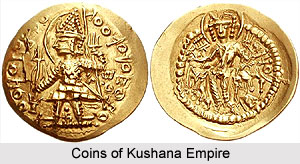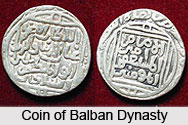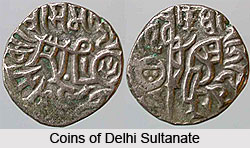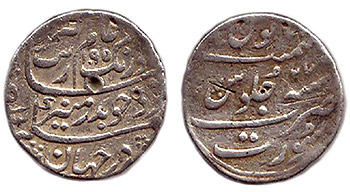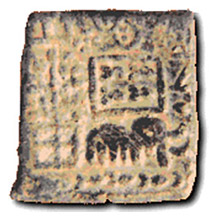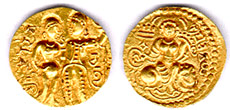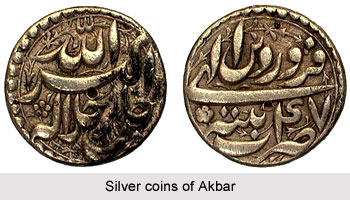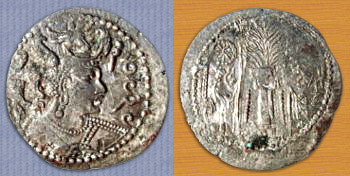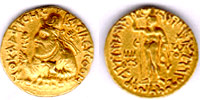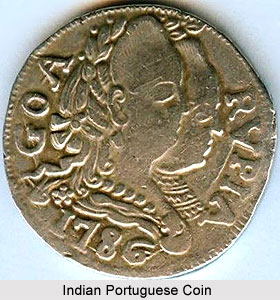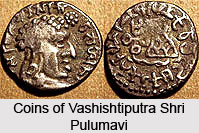 One of the most celebrated dynasty of ancient India, ruled over large area of modern western and southern India (Maharashtra, Gujarat, Andhra Pradesh, Karnataka and Goa states is the Satvahana dynasty. This dynasty has a unique distinction of issuing the coin with the portrait of ruler. No other native ruler or indegenous dynasty issued portrait type coins till one of the Satvahana ruler, Vashishtiputra Shri Pulumavi issued the portrait type coins. Most the coins minted by Satavahanas were made of lead or copper. For some coins they have used potin (an alloy of lead and copper) and Billon (an alloy of silver and copper). Numismtic studies played crucial role in deciphering history of Satavahana dynasty. Some of the rulers who otherwise find no mention in Puranas (the contemporary texts which provide Satavahana chronology) are known only from their coinage. Satavahan coins do not possess high degree of artistic beauty but their silver portrait coins, essentially minted in Kshatrapa fabric are unique in style. Some of the physical traits depicted on these coins (eg. curly hairs, long ears, their lips etc) suggests their Dravidian origin, and thus might be their real portraits rather the stylized version. Most of the Satavahana coins have elephant, lion, horse, or chaitya on obverse while reverse side shows `Ujjain symbol`, a cross with four circles at the end.
One of the most celebrated dynasty of ancient India, ruled over large area of modern western and southern India (Maharashtra, Gujarat, Andhra Pradesh, Karnataka and Goa states is the Satvahana dynasty. This dynasty has a unique distinction of issuing the coin with the portrait of ruler. No other native ruler or indegenous dynasty issued portrait type coins till one of the Satvahana ruler, Vashishtiputra Shri Pulumavi issued the portrait type coins. Most the coins minted by Satavahanas were made of lead or copper. For some coins they have used potin (an alloy of lead and copper) and Billon (an alloy of silver and copper). Numismtic studies played crucial role in deciphering history of Satavahana dynasty. Some of the rulers who otherwise find no mention in Puranas (the contemporary texts which provide Satavahana chronology) are known only from their coinage. Satavahan coins do not possess high degree of artistic beauty but their silver portrait coins, essentially minted in Kshatrapa fabric are unique in style. Some of the physical traits depicted on these coins (eg. curly hairs, long ears, their lips etc) suggests their Dravidian origin, and thus might be their real portraits rather the stylized version. Most of the Satavahana coins have elephant, lion, horse, or chaitya on obverse while reverse side shows `Ujjain symbol`, a cross with four circles at the end.
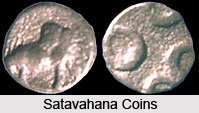 While the Marathas have had a long history, they came into the limelight in the seventeenth century led by the charismatic leader Shivaji. The Maratha Confederacy consolidated itself after Aurangzeb`s death in 1707 AD. Their military successes saw them overrun most of India by 1738 AD. They suffered a setback with the battle of Panipat in 1761 AD. As regards coinage, Shivaji first issued coins in 1664 AD when he assumed the title of Raja. Coins were again issued to commemorate his coronation at Raigadh in 1674 AD. These coins are rare. Maratha Mints and coinage were consolidated around the middle of the eighteenth century. Three types of Rupees were in circulation during this period, viz., the Hali Sicca, the Ankushi rupee which was the standard rupee of Pune, and the Chandori rupee which was on par with the Ankushi.
While the Marathas have had a long history, they came into the limelight in the seventeenth century led by the charismatic leader Shivaji. The Maratha Confederacy consolidated itself after Aurangzeb`s death in 1707 AD. Their military successes saw them overrun most of India by 1738 AD. They suffered a setback with the battle of Panipat in 1761 AD. As regards coinage, Shivaji first issued coins in 1664 AD when he assumed the title of Raja. Coins were again issued to commemorate his coronation at Raigadh in 1674 AD. These coins are rare. Maratha Mints and coinage were consolidated around the middle of the eighteenth century. Three types of Rupees were in circulation during this period, viz., the Hali Sicca, the Ankushi rupee which was the standard rupee of Pune, and the Chandori rupee which was on par with the Ankushi.
The western and central part of India consisting of Saurashtra and Malwa (modern Gujrat and neighbouring Maharashtra, Rajasthan and Madhya Pradesh states) was ruled by rulers known as Ksatrapa or Kshatrapas. The early Ksatrapas became independent rulers by carving out a principality on the ruins of Satavahana empire. These kings have minted some of the most fascinating silver coins of Indian numismatic history. The life-like portraits of the rulers of early rulers suggests that different dies were made as king grew older, clearly indicating the high degree of care taken while minting their coinage. These remarkable series of silver coins became extremely popular not only in the western provinces directly goverend by Kshatrapa rulers but also in the adjoining regions, possibly whole of northern and western India. These coins with complete name of ruler, his father`s name and date of issue, provided historians necessary evidence for determination of genealogy of not only the Kshatrapa rulers but also immensely helped in deciphering the duration of reigns of their contemporary rulers in adjoining empires.
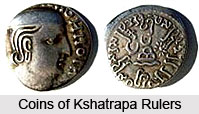
The coins under the rule of king Nahapana who conquered a large part of western and central India, show his diademed bust with Greek legends on obverse, which is the reminiscent of Indo-Greek coinage. The reverse shows arrow and thunderbolt with legends in Prakrit (in heavily Sanskritized form) written in Kharoshti and Bramhi scripts. All the coins of later Kshatrapas bear the chaitya or three arched hill and river symbol on reverse of their coins, instead of thunderbot and arrow. A coin of Rudrasen bears Bramhi inscription, which reads, Rajanah Ksatrapasa Viradamaputrasa Rajno Mahakstrapasa Rudrasensa, on reverse, which can be translated as King Kshatrapa Viradaman`s son King Mahakshatrapa Rudrasena.
Guru Nanak laid the foundations of a religious community, which gradually metamorphised into the Sikh Empire, a formidable military power in North Western India. It was with the defeat of Ahmad Shah Durrani at Sirhind in 1710, that the Sikh league also known as Khalsa, came into its own. The whole tract of land between Jhelum and Sutlej was divided among the Sikh chieftains. Around 1777 AD, coins were issued from Amritsar without the name of the Mughal Emperor and were called `Nanak Shahi`. These coins bore the name of Guru Gobind Singh, the tenth and the last Guru of the Sikhs. The most distinguished statesman amongst the chieftains was Ranjit Singh who successfully recaptured Amritsar, Ludhiana, Multan, Kashmir and Peshawar. The treaty of 1809, with the British, confirmed his right to rule the tracts he had occupied south of Sutlej.
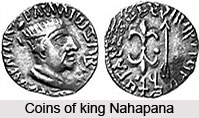 However, after his death, the Sikh Empire began to deteriorate and was finally annexed to the British Empire in 1849. Most coins struck during the reign of Ranjit Singh bear a large leaf on one side and bear Persian legends. He also introduced coins with Gurumukhi legends, mostly of the copper variety.
However, after his death, the Sikh Empire began to deteriorate and was finally annexed to the British Empire in 1849. Most coins struck during the reign of Ranjit Singh bear a large leaf on one side and bear Persian legends. He also introduced coins with Gurumukhi legends, mostly of the copper variety.
In Gujarat, Bhattaraka established a new independent kingdom during decline of Gupta Empire. Maitraka family ruled this new kingdom of Valabhi for next 350 years. All the coins issue by Valabhi rulers were in the name of Bhattaraka, who took a title of Senapati, army general. The coins of this dynasty are minted in kshatrapa style depicting bust of ruler (highly stylize in the later issues) on obverse, while reverse depict the trident (shastra or weapon of Lord Shiva) with or without sidearm. The legends are present on reverse written in Brahmi script, which reads Rajno Mahakshatrapa Paramaditya Bhakta Mahasamanta Sri Sarva Bhattarakasa. Post-Gupta era clearly show decline in artistry in coinage. Except few, most rulers hardly paid any attention towards their coinage. Unlike Gupta and Kushan emperors who used their coinage for propaganda and minted fine specimen of numismatic arts, post-Gupta successors rarely experiemnted with their coinage. Most of the time post-Gupta rulers copied motifs from earlier Gupta coinage. Thus often coinage of whole dynasty was struck in name of one (or two rulers) with identical motifs except the later coinage is debased compared to the earliest. Many of these post Gupta rulers were more involved in building temples and other works of art rather than minting coins.
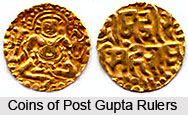 Pratiharas, claiming to be a descent from Lakhamana, brother of Lord Rama created an Empire, which was similar in size of his predecessor, Harsha-Vardhana. He built a city Bhojpal (modern Bhopal, capital of Madhya Pradesh state) that was named after him. One of the coins of this dynasty, the obverse show
Aadivaraha, boar like incarnation of Lord Vishnu while reverse of the coin show stylized fire altar and two attendant. The deity Aadivaraha is supposedly holding earth by his snout. The vigor and strength of Aadivaraha`s image on these coins amply show die engraver`s knowledge of sculptures of that era. The coins of Bhoja were immensely popular in medieval period and were extensively copied by his successors. All the kings of Pratihara dynasty minted exact same coin, which were introduced by Bhoja I. Although the coins of later rulers of Pratihara dynasty were more stylized.
Pratiharas, claiming to be a descent from Lakhamana, brother of Lord Rama created an Empire, which was similar in size of his predecessor, Harsha-Vardhana. He built a city Bhojpal (modern Bhopal, capital of Madhya Pradesh state) that was named after him. One of the coins of this dynasty, the obverse show
Aadivaraha, boar like incarnation of Lord Vishnu while reverse of the coin show stylized fire altar and two attendant. The deity Aadivaraha is supposedly holding earth by his snout. The vigor and strength of Aadivaraha`s image on these coins amply show die engraver`s knowledge of sculptures of that era. The coins of Bhoja were immensely popular in medieval period and were extensively copied by his successors. All the kings of Pratihara dynasty minted exact same coin, which were introduced by Bhoja I. Although the coins of later rulers of Pratihara dynasty were more stylized.
Spalapati Deva first minted the coins of the Hindu Shahi of Kabul in mid-ninth century. Later on the Samanta Deva coinage was used as prototype for increasingly debased coinage struck by many dynasties. The reverse of these well-executed silver coins display a recumbent bull partly draped with an ornamental cloth and stamped with the mark of trident on his rear flank.
The gold coins of the Rajput dynasty in Central India, were almost always had stylized Laxmi on obverse, the design of which was essentially derived from Gangeyadeva coinage (originally from Gupta coins), while reverse had name of the ruler in Devnagri script. The weight of these gold coins was maintained to be four and half Masha, which is equivalent to 3.6 gms. The silver coinage was almost entirely copied from Bull-Horseman type coin of Hindu Shahi of Kabul.
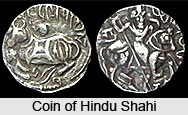
Then came the Chauhan dynasty, in the middle of the 11th century. The gold coin of this great king, Vigraharaja, of Chauhan dynasty, is very special as the obverse of coin show Lord Rama, hero of epic Ramayana wandering in forest. A bird like creature (possibly a peacock) is shown in left hand corner. This is very interesting coin and represent only numismatic representation of this favourite deity of Hindus. The obverse also shows the legend Shri Ra Ma writen in Devnagri script. The reverse shows name of King Vigraharaja in Devnagri script.
